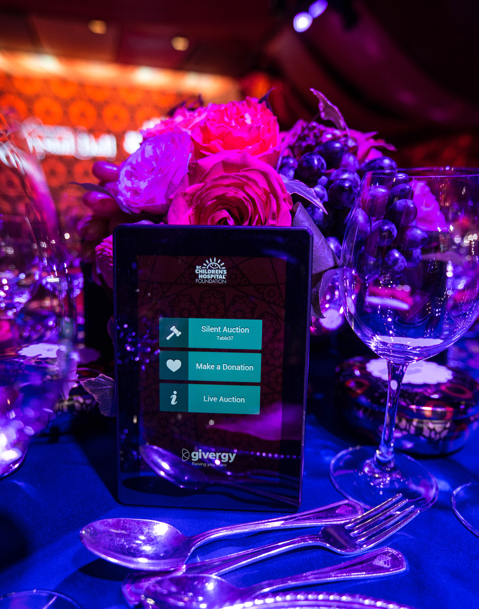FROM PAPER BIDDING TO INTERACTIVE SILENT AUCTIONS WITH TRACEY WADE

From paper bidding to interactive silent auctions, Givergy met with Vancouver fundraising professional Tracey Wade to get her firsthand experience using fundraising technology.
About Tracey: Tracey has become an expert in the nonprofit industry in Canada over the years thanks to her involvement, passion and dedication to the sector. Having worked on both coasts and traveled the world to organize and participate in fundraising events, she brings to us some precious insight on what is it like to shift from pen and paper bidding to fundraising technology. Givergy were lucky to have the opportunity to chat with Tracey and pick her brain to bring you these great tips and stories to help you on your fundraising journey to raising more.
G: What has been the biggest challenge in the industry since you started?
T: The lack of ability to keep up to the new ways of communicating with the donors and guests. [There are a] lot of inaccurate databases that are not updated in ways that one can use to expand the reach of an organization. The reach becomes so much smaller due to the lack of forethought.
G: What do you think the solution to this challenge is?
T: Bring in new blood to each organization; people who understand the advantage of technology and who know how to use it to maximize donor potential.
G: Have you ever worked with fundraising technology? When did you first see fundraising technology at events?
T: Yes, at many events! I introduced Givergy in its former form (Daana) to Vancouver. I am involved with one of Vancouver’s premier fundraising events for all parts of BC and we were looking for something newer and fresher, a better approach to doing auctions and I tested every option on the global market.
I went to the Givergy headquarters in the UK and talked to the managing director to see what we could do to make it work for us. And so we did try [Givergy] 2 years ago and it was a great success! I became the point of contact here in Vancouver doing fundraising events for Givergy and it pretty much spread all over since.
G: What made you opt for Givergy?
T: When I met with the managing director in the UK, he was very happy to meet with me, and [Givergy] were very open with their facility. I got an idea of the employees and the culture. In all, it was an interesting few hours that I spent there. I really appreciated the opportunity to develop a few of the niche items that I wanted or that I thought would be a good fit in our market, and [I also liked] their secured network. Most of the other networks a few years ago were relying on service. We still only rely on 3G here and some of our events are wonderful old hotels. Wi-Fi and cell reception is not what they are known for inside ballrooms, and having to rely on something that exclusively works with Wi-Fi or cell network was absolutely not a possibility so getting the assurance that Givergy were bringing their complete closed system and a backup if anything went wrong took me from being skeptical to signing.
G: How did the guests react to the fundraising technology?
As expected, our older guests were not pleased with change. The idea is to ensure that you engage your core [guests] and your new guests. [It is also important] to help facilitate the change for our older guests, so we were able to target [them], and offer them extra assistance to make them more comfortable. We increased our bottom line around 15 to 20%, which is quite a phenomenal opportunity upon introduction. Keep in mind that our entire crowd had not seen any technology [at fundraising events] yet, or if they did, it was in other countries, in different form, like I had. So it was new, and usually new means you lose something on your bottom line the first time out, but I predicted this would not be the case.
Fundraising Technology
G: During the event, how did the technology make a difference?
T: [It helped with] keeping people seated during the program; and kept their focus on the ceremony. Basically, there is no excuse to get up to go look at the auction because it is on the tablet right in front of you. And other than dollars, our biggest take home the first time around was our ability to keep people in place. We call it butts in seats. It is such an essential component of what we do and this allowed us to give a lot of assistance. Plus, you can add all sorts of extra information on the tablet: details on the organization, pictures showing the lot items, and the ability to thank particular people such as sponsors. You have all sorts of options. [Besides] people are so used to their tablets and cellphones that when you give it to them they hold on to them and they use them. They put their phone down because now they don’t need it as they have this other thing in their hand. Overall it was just a very great option for us and it worked well.
G: What would you advise to someone new in the fundraising industry?
T: Don’t be misled by bright shiny things: if numbers don’t add up, they don’t add up. Also, you have legal responsibility in fundraising to ensure transparency and if you are not doing that, you are on the wrong side.
G: Do you see a difference between the West and East coast?
T: Yes, [its a] pretty close market, once people start [being part of the nonprofit industry], they seem to stay in the fundraising network for a long time. [In Vancouver], we all kind of battle. Its a small group of social people and all the bigger organizations are pulling from the same pool. We have less of a pool than Eastern Canada does for instance, such as Toronto. They have a lot more people so it makes it easier for them to have larger events. [However], in terms of ability, we all operate under the same envelope.
G: What do you think will be the challenges for the future in the industry?
T: People are mobile, they are not linked to towns nor organizations. [You] have to keep them engaged with your cause, and perhaps it would require a lot more use of current and future technology. I feel like a lot of the charitable organizations definitely are making the most of it. For example Free the Children is excellent with their online capacity. They are doing really well, but some of the older ones are not with the times so I think that is the biggest challenge.
Thank you Tracey for this great insight into your world of fundraising! We wish you luck on your future fundraising ventures.
If you are interested in learning more about how Givergy can assist you with the transition into fundraising technology, please do not hesitate to contact us.
Tim Stansbury
Director and Fundraising Consultant
Tim joined Givergy in 2010, overseeing the early stage growth of the business to 50 employees across five international regions, supporting over 4,000 events worldwide. With a passion for leadership, business growth and exceptional standards, Tim is at the heart of all clients needs both in the UK and worldwide.
Fundraise Completely Free with Givergy: Here’s How
March 28, 2025
20 School Fundraising Ideas That Make a Big Impact
March 21, 2025
Heads or Tails Fundraising: A Simple Game to Boost Your Event Revenue
March 21, 2025
25 Simple Fundraising Ideas for Nonprofits: Creative Ways to Engage Your Community
March 14, 2025
9 Simple Fundraising Ideas for Sports Clubs
March 7, 2025


